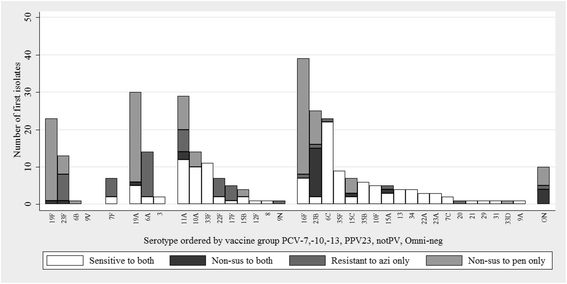Reduced middle ear infection with non-typeable Haemophilus influenzae, but not Streptococcus pneumoniae, after transition to 10-valent pneumococcal non-typeable H. influenzae protein D conjugate vaccine
- PMID: 26482232
- PMCID: PMC4615539
- DOI: 10.1186/s12887-015-0483-8
Reduced middle ear infection with non-typeable Haemophilus influenzae, but not Streptococcus pneumoniae, after transition to 10-valent pneumococcal non-typeable H. influenzae protein D conjugate vaccine
Abstract
Background: In October 2009, 7-valent pneumococcal conjugate vaccine (PCV7: Prevenar(TM) Pfizer) was replaced in the Northern Territory childhood vaccination schedule by 10-valent pneumococcal Haemophilus influenzae protein D conjugate vaccine (PHiD-CV10; Synflorix(™) GlaxoSmithKline Vaccines). This analysis aims to determine whether the reduced prevalence of suppurative otitis media measured in the PHiD-CV10 era was associated with changes in nasopharyngeal (NP) carriage and middle ear discharge (ED) microbiology in vaccinated Indigenous children.
Methods: Swabs of the NP and ED were collected in remote Indigenous communities between September 2008 and December 2012. Swabs were cultured using standardised methods for otitis media pathogens. Children less than 3 years of age and having received a primary course of 2 or more doses of one PCV formulation and not more than one dose of another PCV formulation were included in the primary analysis; children with non-mixed single formulation PCV schedules were also compared.
Results: NP swabs were obtained from 421 of 444 (95%) children in the PCV7 group and 443 of 451 (98%) children in the PHiD-CV10 group. Non-mixed PCV schedules were received by 333 (79%) and 315 (71%) children, respectively. Pneumococcal (Spn) NP carriage was 76% and 82%, and non-typeable Haemophilus influenzae (NTHi) carriage was 68% and 73%, respectively. ED was obtained from 60 children (85 perforations) in the PCV7 group and from 47 children (59 perforations) in the PHiD-CV10 group. Data from bilateral perforations were combined. Spn was cultured from 25% and 18%, respectively, and NTHi was cultured from 61% and 34% respectively (p = 0.008).
Conclusions: The observed reduction in the prevalence of suppurative OM in this population was not associated with reduced NP carriage of OM pathogens. The prevalence of NTHi-infected ED was lower in PHiD-CV10 vaccinated children compared to PCV7 vaccinated children. Changes in clinical severity may be explained by the action of PHiD-CV10 on NTHi infection in the middle ear. Randomised controlled trials are needed to answer this question.
Figures


References
-
- Leach AJ, Morris PS. The burden and outcome of respiratory tract infection in Australian and aboriginal children. PediatrInfectDisJ. 2007;26(10 Suppl):S4–S7. - PubMed
-
- Smith-Vaughan HC, Binks MJ, Marsh RL, Kaestli M, Ward L, Hare KM, Pizzutto SJ, Thornton RB, Morris PS, Leach AJ. Dominance of Haemophilus influenzae in ear discharge from Indigenous Australian children with acute otitis media with tympanic membrane perforation. BMC Ear Nose Throat Disord. 2013;13(1):12. doi: 10.1186/1472-6815-13-12. - DOI - PMC - PubMed
-
- Deloria Knoll M, Park DE, Johnson TS, Chandir S, Nonyane BA, Conklin L, Fleming-Dutra KE, Loo JD, Goldblatt D, Whitney CG, et al. Systematic review of the effect of pneumococcal conjugate vaccine dosing schedules on immunogenicity. Pediatr Infect Dis J. 2014;33(Suppl 2):S119–129. doi: 10.1097/INF.0000000000000079. - DOI - PMC - PubMed
Publication types
MeSH terms
Substances
LinkOut - more resources
Full Text Sources
Other Literature Sources
Medical
Miscellaneous

